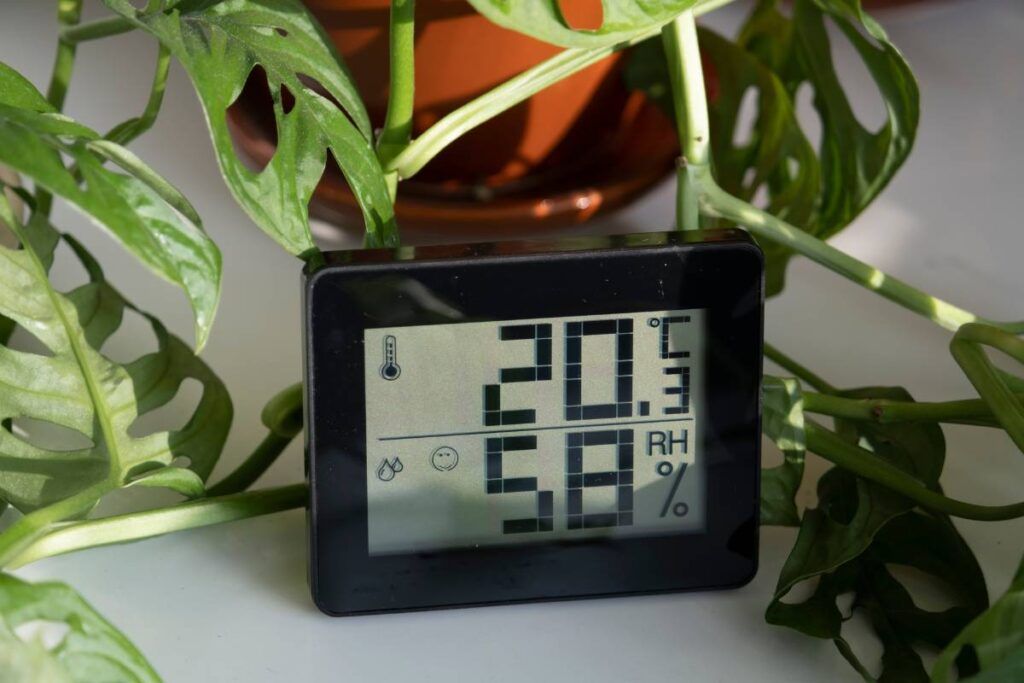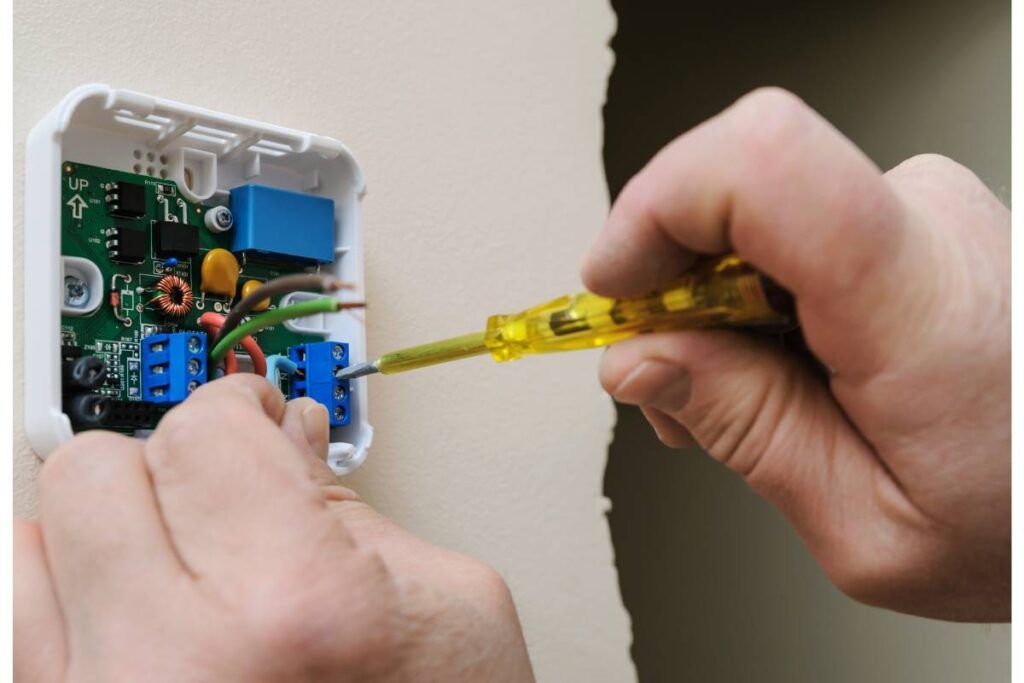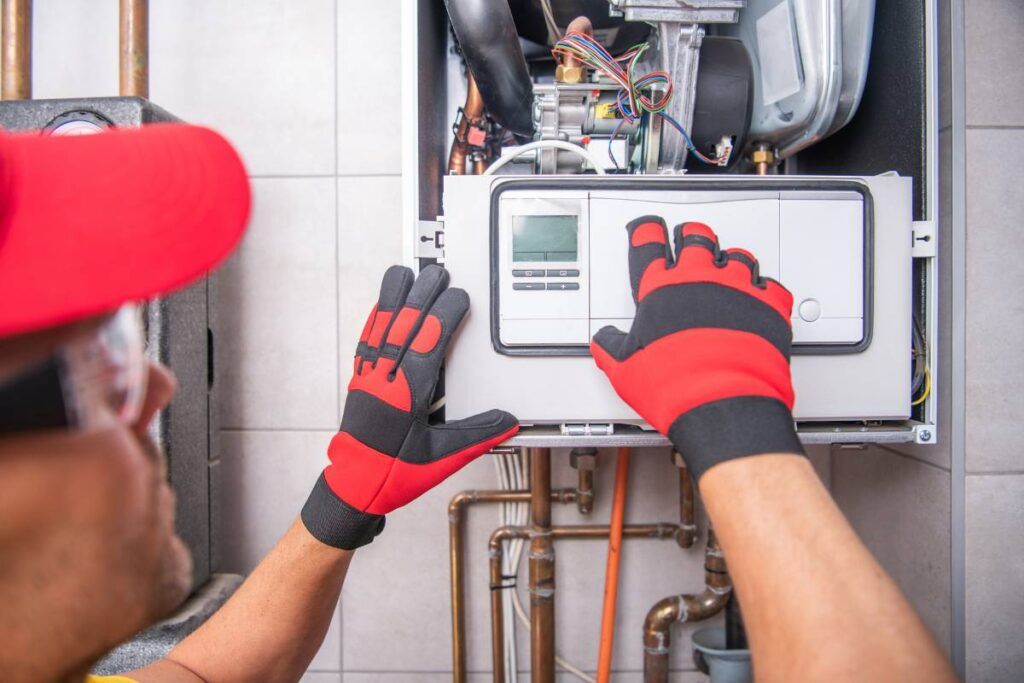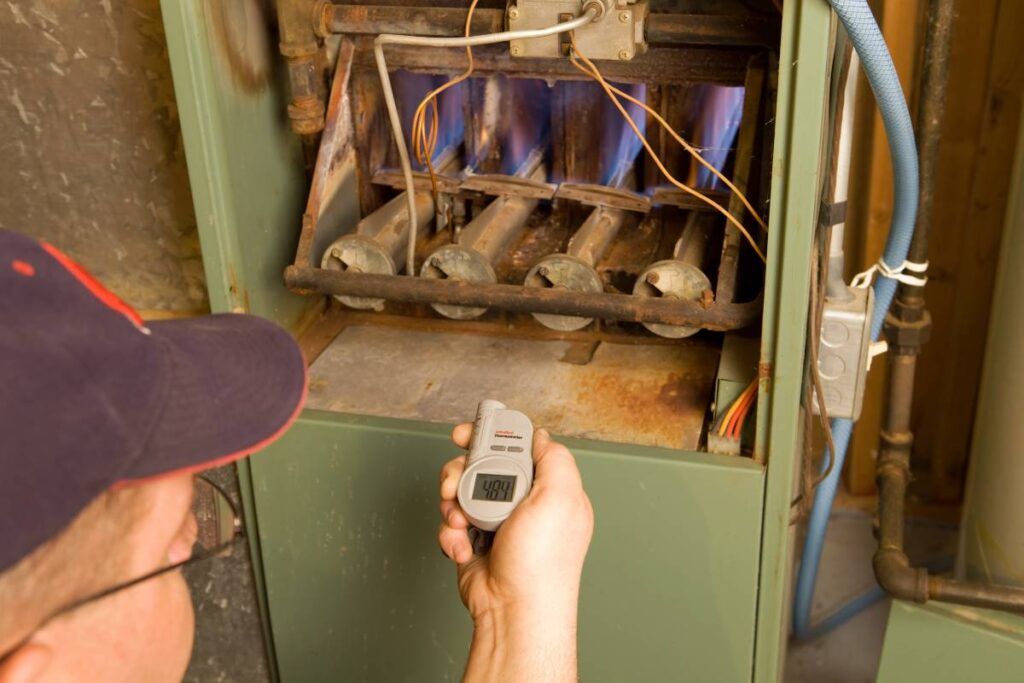A furnace is meant to produce adequate heat for your house. But it is frustrating to see it not heating. Besides, the unit will keep running to give you the desired temperature and end up overheating. So, when a furnace does not provide enough heat, check and fix the problem.
The primary reasons your furnace is not heating include dirty air filters, thermostat issues, blocked vents, leaking ductwork, and insufficient gas. Potential fixes are clearing the air filters and vents, sealing the duct leaks, setting the thermostat, and ensuring enough gas.
There are many more reasons, and this article will share all the major and minor problems behind a furnace not heating up. If you cannot understand the reason behind the problem, consider calling an HVAC expert.

Check out our list of top-handpicked products for all your electrical, appliance, and HVAC system needs to keep your home running smoothly.
This post includes some affiliate links.Why is your furnace not heating?
The biggest problem is identifying the exact problem with your furnace and the method of troubleshooting it.
To find it out, you must observe the behavior of the furnace and ask yourself certain questions, for example:
- When did the furnace stop heating?
- Is there any leakage?
- When was the last time you fired up the furnace?
- What is the heat source?
- What type of thermostat do you use?
- What kind of heating system do you have?
Asking these questions will help you identify the main issue because the problem can be as simple as the thermostat setting or as major as a faulty blower motor.
The problem could also be in the gas regulator or a bad flame sensor.
These are the safety measures that prevent your furnace from working properly.
Now, let’s get into the reasons without further delay.
1. Thermostat issues
Thermostats might get turned off, or settings can get flipped by mistake, for which your furnace will not heat up.
Or, your thermostat may have understandably turned off for a reset cycle.
Even the slightest change can make your thermostat work differently, for which the furnace may not work properly.
The thermostat is connected to the furnace to regulate the unit’s heating.
These thermostat issues can make your furnace stop heating based on the temperature, status, and room size.
Another reason is dead batteries.
A furnace will only start heating when the thermostat sends signals to the unit after you set a certain temperature.
If the thermostat has a low battery, it won’t let your furnace heat your room.

Wire problems also do the same thing.
The white wire helps in heating the room.
If the wire is frayed or loose, the thermostat won’t be able to signal your furnace to heat your room.
Make sure that all the wires in the thermostat are tight.
If they are loose, tighten them with screws or ask for an expert’s help.
Change the batteries from time to time.
If your thermostat is set to COOL, change it and set it to AUTO or ON.
Raise the temperature to 5 degrees more than the room temperature.
If the thermostat is dirty, open the cover and dust around the coils and contact plate with a soft paintbrush.
3. Loose or worn out belt or faulty blower motor
You will hear a hissing or squealing sound from your furnace sometimes.
The reason is a loose belt, especially if the furnace is very old.
These belts can wear and tear and release a burning smell from your unit.
You must turn off your furnace and contact an HVAC professional.
Sometimes, the belt might be fine, but the blower motor might have been worn out due to the daily wear and tear.
The motor bearings may also get locked up.
The motor needs to be replaced.
Other signs of a faulty blower motor are high energy bills, overheating, or weird noises.
You cannot fix the problem yourself. You need an HVAC expert to handle the matter.
4. Blocked blower

The blower could accumulate dirt and debris if your furnace is quite old.
If the blower is blocked due to dirt accumulation, it cannot move properly.
As a result, the hot air cannot circulate through the ducts to your house efficiently.
If you do not fix the problem, it can also damage your heat exchanger after some time.
To resolve the situation:
- Turn off the furnace.
- Remove the unit’s screw to lift the outer panel.
- Unscrew the panel covering the blower motor and disconnect the wires.
- Remove the shelf’s bolts on which the control panel sits and lift out the panel.
- Unscrew the motor and fan to remove them.
- Use a handheld vacuum with a brush attachment to clean the wheel fins.
- Once you have cleaned, put everything back in place and turn on the furnace to check.
If you cannot resolve it yourself, call an HVAC expert.
5. The blower capacitor is not working
A blower capacitor works like a battery to help the furnace’s blower operate power.
When the capacitor fails to work, the blower will stop working and fail to spread the hot air. Additionally, it will make loud noises.
Due to a failed blower capacitor, the furnace will not be able to produce enough heat.
You will have to replace the capacitor with the help of an HVAC expert.
You can check whether the capacitor is the one creating issues with the following steps:
- Turn off the furnace (and gas supply if it is a gas furnace) and remove the blower to get the capacitor.
- Remove the wires and the capacitor with a screwdriver having an insulated handle across the terminals.
- For dual capacitors, touch the screwdriver from the FAN to the common terminal and then from the HERM to the common terminal.
- Join each terminal to the multimeter’s probes to read the levels.
- Compare the reading with the value written on the capacitor’s side.
- If the reading does not match, you must buy a new capacitor to get it replaced by an HVAC expert.
6. Pilot light problems
In the older furnaces, you will have a pilot light which should remain lit whenever your furnace is on.
If any dirt and debris clog the pilot orifice, it will prevent the light from lighting up.
The pilot light indicates the gas flow to the furnace.
If the light does not ignite, the gas flow will stop, and your furnace will no longer ignite to heat your room.
Sometimes the light won’t be lit up, so the gas does not flow to your furnace.
To fix the problem, hire an HVAC expert.
7. Low pilot light flame

Sometimes, the pilot light’s flame setting becomes too low, and the furnace cannot receive enough gas to heat up.
You need to hire an HVAC expert to fix the light flame.
If you want to try it yourself due to some experience you gather, try the following:
- Find the screw near the pilot light. It will be written ‘pilot adjust.’ The screw will be next to this writing.
- Remove the screw and poke in your screwdriver.
- Light the pilot light.
- Turn the screwdriver until the light increases its flame size.
8. Dirty flame sensor
The flame sensor in the furnace senses the flame to fire up the furnace.
If the sensor is dirty or faulty, it cannot sense the flame to fire up the furnace.
Even if it fires up the furnace burners, the unit cannot heat up properly.
So, it would be best to clean it properly.
To fix the problem:
- Unscrew the front panel of your furnace and close the gas valve.
- Find the small metal rod with a porcelain base on the right side of your furnace.
- Use a nut driver, loosen the rod, and bring it out for cleaning.
- For cleaning, you can use rough paper, light sandpaper, a dollar bill, or emery cloth (3M Emery Cloth, 03008, 3 ⅔ in. x 9 in. 6 sheets per pack).
- Put it back in its place and tighten the screws.
- You need to replace the sensor if you find any missing pieces or cracks.
9. Check for the flame

If your furnace’s flame is out, an HVAC team will need a new one replaced.
Since the flame is the heating element, your furnace won’t heat up if the flame is out.
If the flames are up, but the blower motor is not blowing warm up, and the furnace is not heating, consider turning off the unit for a minute and then turning it on again.
Restarting the unit is an easy fix to start the flames and allow the furnace to heat.
10. Fuel and ignition problems
If your furnace is on but does not produce enough heat in your room, it could be a problem related to the fuel supply or ignition system.
These are two of the main things, among others, that help in heating the furnace.
If you suspect these problems, consider checking the following things:
- Check the gas valve. It should remain on for enough gas flow. Open it if you find it closed.
- Check the gas tank to ensure enough gas is left if you have a gas furnace that uses liquid propane or oil as the heating fuel. Call your gas supply to refill the tank if there isn’t.
- If you use natural gas, call the provider for any interruption.
- If the furnace has an electronic ignition system, the metal strip of the igniter switch might be dirty. Gently clean it off, but since the component is fragile, call an HVAC for help.
11. Dirty air filters
When you turn on the furnace, it takes in the cold air to heat it and spread throughout your house.
While taking in the cold air, the air gets filtered through the filter, and all the dirt and air particles get stuck.
Over time, the filter will become dirty and block the warm air from spreading.
So, the furnace will no longer heat your room.
You need to check the filters once a month and change them every 3 to 4 months.
Open the furnace and look for the filter inside. Try checking it through to estimate the dirt level.
Remove the filter from its slot and replace it with a new filter.
If your filter is washable, remove the filter and wash it.
Let it dry with a paper towel and put it back in place.

Avoid using any harsh chemicals.
The frequency of changing filters depends on the size:
- 1 to 2-inch filters – Replace them every 1 to 3 months
- 3 to 4-inch filters – Replace every 6 to 9 months
- 5 to 6-inch filters – Replace every 9 to 12 months
12. Leaky ducts
The ductwork runs through your house to supply hot air from the furnace to all the rooms.
The ducts must be sealed enough so that the hot air does not lose through any leaks.
Generally, ductwork can lose up to 40% of air. An extra 20% of the heat will escape if there is a leakage.
If 60% of heat escapes through the leaks, your house will receive insufficient warm air from your furnace, no matter how hard your furnace is working.
A visual inspection is required.
Walk along the duct system of your house to look for signs of leaks, cracks, dings, or holes.
Turn the furnace on before you walk along the ductwork to understand from which place the air is leaking.
Call an HVAC expert to seal the ducts.
13. Blocked or closed air vents
Your air vents can get blocked due to some objects or furniture.
Sometimes, people turn off the vents for rarely used rooms to save energy bills.
The air vents allow the air to distribute throughout your house.
When the furnace heats the air, the blower will spread the air through the ductwork to your house.
The air is pushed out to all the air vents found in the building to spread all the rooms.
Any blockage or closing will not let the air escape.
As a result, your furnace won’t heat your room properly.

Additionally, the vents will forcefully try to release the air and end up with constant wear and tear.
Also, if the vents of some rooms are open, the blocked air will enter these rooms and make them exceptionally hot.
Take a walk through your house, especially in areas where the vents are present, and check if they are closed or blocked.
Open up the closed vents and remove the objects blocking them.
14. Wrong furnace size
Furnaces are available in various sizes.
Before you buy one for your house, you need to know the measurement of your house.
The right size depends on the house size. For example, a 1,200 square footage will require a 36,000 to 72,000 BTU furnace, and a 1,500 square footage will need a 45,000 to 90,000 BTU furnace.
The furnace size also varies based on the lowest temperature of your zone.
For 1,200 square footage, you can get a 36,000 BTU furnace if the temperature is average.
But if the temperature is much lower than tolerable, you need a 70,000 BTU furnace.
That is how the furnace size varies.
If you choose a smaller furnace, it will struggle to give you the desired temperature but only in vain.
As a result, your furnace won’t be able to heat your room enough.
So, you must choose the right furnace size. Here is a small guide to help you:
- 1,200 square feet area – 36,000 to 72,000 BTUs
- 1,500 square feet area – 45,000 to 90,000 BTUs
- 1,800 square feet area – 54,000 to 108,000 BTUs
- 2,100 square feet area – 63,000 to 126,000 BTUs
- 2,400 square feet area – 72,000 to 144,000 BTUs
15. Poor insulation
Sufficient insulation in the house will let your furnace work properly and give you enough heat.
But with poor insulation, your house will receive all the cold outside air.
As a result, the heat provided by your furnace won’t be enough to heat your room.
All the furnaces use a recommended amount of heat level.
If your house has poor insulation, you may have to use it higher than the recommended level, which can increase the energy bills.
Besides, your furnace has to work harder than normal without stopping.
Also, Drafty windows are another reason behind the furnace’s not heating enough.

Make sure your house has adequate insulation.
If you have drafty doors and windows or they have cracks, consider sealing them with caulk or weather stripping.
If you already have weather stripping, they might have been worn out. Replace them with new ones.
16. Maintain your furnace regularly
Many people have furnaces since they are important, especially during the winter.
But unfortunately, they do not touch or observe its behavior post-installation.
As long as it provides heat, the house owners forget its existence.
So, not attending regular maintenance and servicing will raise issues, not heating being one of them.
Furnace maintenance ensures the unit’s efficiency and smooth functioning.
For proper maintenance of your furnace:
- Keep the air filters clean and free of debris and dirt. Check them monthly and change or clean them every 3 to 4 months.
- Test the carbon monoxide detectors for proper working
- Make sure the furnace does not collect any dirt and debris inside.
- Ensure that the flame sensor is clean and does not have any cracks.
Also check:
- Furnace Only Works After Reset: 9 Problem+Fix
- 15 Reasons Your Furnace Won’t Turn On (+Fix)
- 14 Reasons Your Furnace Won’t Turn Off (+Fix)
Final thoughts
A furnace failing to heat will have multiple reasons.
Some are simple fixes, and some need an HVAC expert.
For example, cleaning the air filters and flame sensors and fixing the thermostat issues are simple problems.
Others will require the HVAC’s attention.
Knowing the reason will let you know whether you must call for help and prevent you from delaying the troubleshooting.
Reference: Wikipedia.
